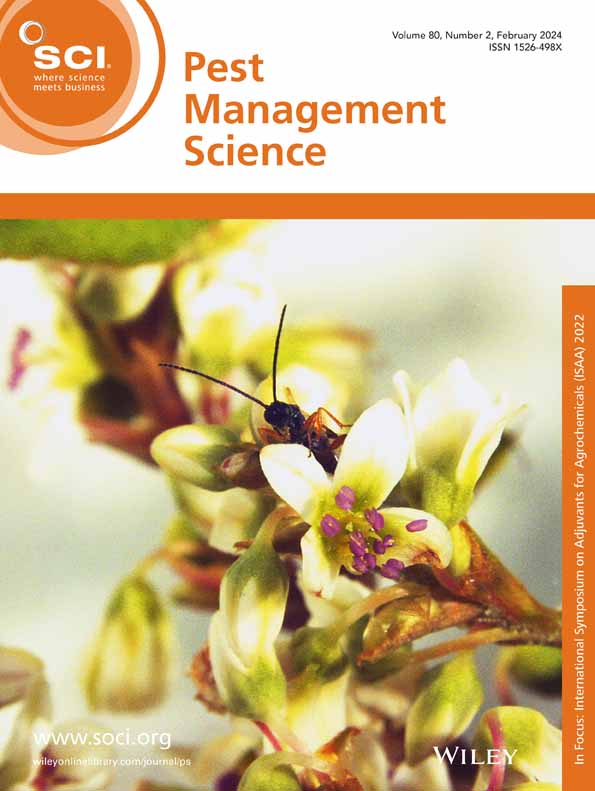Ecotoxicology of microplastic contamination: insights into the pest defense of Ulmus pumila and pest control efficiency of Bacillus thuringiensis.
IF 3.8
1区 农林科学
Q1 AGRONOMY
引用次数: 0
Abstract
BACKGROUND The situation of microplastic pollution in terrestrial ecosystems is becoming increasingly severe. This study developed a polyethylene (PE) microplastic-contaminated soil-Ulmus pumila-Hyphantria cunea larvae food chain model to investigate the ecotoxicological impacts of soil microplastic pollution from the perspective of pest occurrence and pest control. RESULTS After feeding on PE-treated U. pumila leaves, the body weight, body length, head capsule width and nutrient content of H. cunea larvae were significantly reduced, accompanied by disrupted expression levels of growth regulatory genes. PE stress significantly reduced the content of nutrients and chlorophyll in U. pumila leaves and inhibited the expression of key genes in glucose and amino acid metabolism pathways. PE treatment also significantly reduced the content of secondary metabolites (flavonoids and total phenolics) and the expression levels of key genes in the flavonoid synthesis pathway (e.g., FLS and CHS) in the leaves. The combined treatment of PE and Bacillus thuringiensis (Bt) significantly increased the mortality and weight inhibition rate of H. cunea larvae in a synergistic manner. The combined treatment of PE and Bt aggravated the breakdown of innate immunity in larvae, including cellular and humoral immunity. PE and Bt combined treatment significantly increased the expression of apoptosis genes in larval midgut, as well as decreased the nutrient content and energy metabolism gene expression levels of larvae compared with Bt treatment alone. CONCLUSION Microplastic pollution reduces the defense of U. pumila against H. cunea larvae in a self-damaging manner, and Bt proves effective for controlling H. cunea larvae in microplastic-contaminated environments. © 2025 Society of Chemical Industry.微塑料污染的生态毒理学:榆的害虫防御和苏云金芽孢杆菌的害虫防治效果。
陆地生态系统中微塑料污染的形势日益严峻。本研究建立聚乙烯(PE)微塑料污染土壤-小榆-棘球蚴食物链模型,从害虫发生和防治的角度研究土壤微塑料污染的生态毒理学影响。结果取食pe处理过的美洲美洲夜蛾叶片后,美洲美洲夜蛾幼虫的体重、体长、头囊宽度和营养成分含量均显著降低,生长调控基因的表达水平被破坏。PE胁迫显著降低了pumila叶片营养物质和叶绿素含量,抑制了葡萄糖和氨基酸代谢途径关键基因的表达。PE处理还显著降低了叶片次生代谢物(黄酮类物质和总酚类物质)含量以及黄酮类合成途径关键基因(FLS和CHS)的表达水平。PE与苏云金芽孢杆菌(Bacillus thuringiensis, Bt)联合处理显著提高了中国家蝇幼虫的死亡率和抑重率。PE和Bt联合处理加重了幼虫固有免疫的破坏,包括细胞免疫和体液免疫。与单独处理相比,PE和Bt联合处理显著提高了幼虫中肠细胞凋亡基因的表达,降低了幼虫营养物质含量和能量代谢基因的表达水平。结论微塑料污染以自毁性的方式降低了美洲锥虫对美洲锥虫幼虫的防御能力,Bt对微塑料污染环境下美洲锥虫幼虫的控制是有效的。©2025化学工业协会。
本文章由计算机程序翻译,如有差异,请以英文原文为准。
求助全文
约1分钟内获得全文
求助全文
来源期刊

Pest Management Science
农林科学-昆虫学
CiteScore
7.90
自引率
9.80%
发文量
553
审稿时长
4.8 months
期刊介绍:
Pest Management Science is the international journal of research and development in crop protection and pest control. Since its launch in 1970, the journal has become the premier forum for papers on the discovery, application, and impact on the environment of products and strategies designed for pest management.
Published for SCI by John Wiley & Sons Ltd.
 求助内容:
求助内容: 应助结果提醒方式:
应助结果提醒方式:


